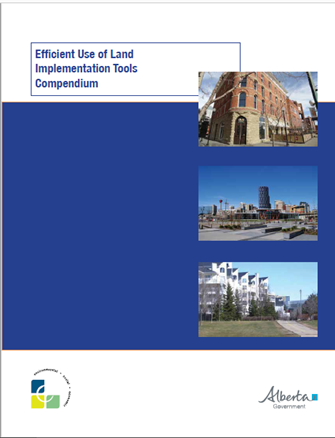Efficient Use of Land Implementation Tools Compendium
To help promote the efficient use of land, the Government of Alberta has completed a review of tools and best practices by municipalities in Alberta and other jurisdictions. The results of this review have been complied into the Efficient Use of Land Tools Compendium to serve as a resource for land-use planners, land users and decision-makers involved in land management planning and decision-making on public and private land.
Decisions that Promote Efficient Use of Land
The Land-use Framework notes examples of land-use decisions that promote efficient use of land:
- minimize the amount of land that is taken from undeveloped or extensive use and placed in permanent use for residential, commercial, industrial, transportation, utility corridors or intensive recreational purposes;
- use “green” technology in new development projects that will reduce the impact on natural systems;
- encourage higher density where redevelopment opportunities occur;
- support development where infrastructure capacity—water, sewer, road and other infrastructure—already exists; and
- planning land uses to reduce the frequency and length of travel for business and pleasure by promoting mixed-use development—industrial, commercial and residential.
Efficient Use of Land Strategy
The strategy is intended to provide land managers and land users a set of broad principles and a tool kit describing a variety of best practices and tools to help reduce the footprint of Alberta’s built environment and promote orderly development.
The strategy will not set regional objectives, but it will offer efficient use of land considerations that should be incorporated into regional and lower level plans. The strategy will also play a key role in supporting the implementation of these plans by providing a suite of tools and best practices that will help governments, decision-makers, planners and landowners achieve land-use planning and efficient use of land objectives.
Efficient Use of Public and Private Land
Land-use efficiency should be commensurate with the level of activity in the region. On public lands where there are multiple users on the same landscape (e.g., forestry and oil and gas), integrated land management should be used to reduce the development footprint. In more densely settled metropolitan areas, the efficiency principle may require more complex strategies such as inter-municipal development plans or metropolitan plans such as the Capital Region Growth Plan: Growing Forward (2009) and the Calgary Regional Partnership: Calgary Metropolitan Plan (2012).
Integrated Land Management
Integrated Land Management (ILM), which falls within the overall scope of efficient use of land, is a strategic, planned approach to the way public land and resources are used. It is a collaborative process between land users and managers that promotes responsible use of lands and aims to reduce human impacts on the landscape with mitigation strategies, integrative planning, and new technologies.






